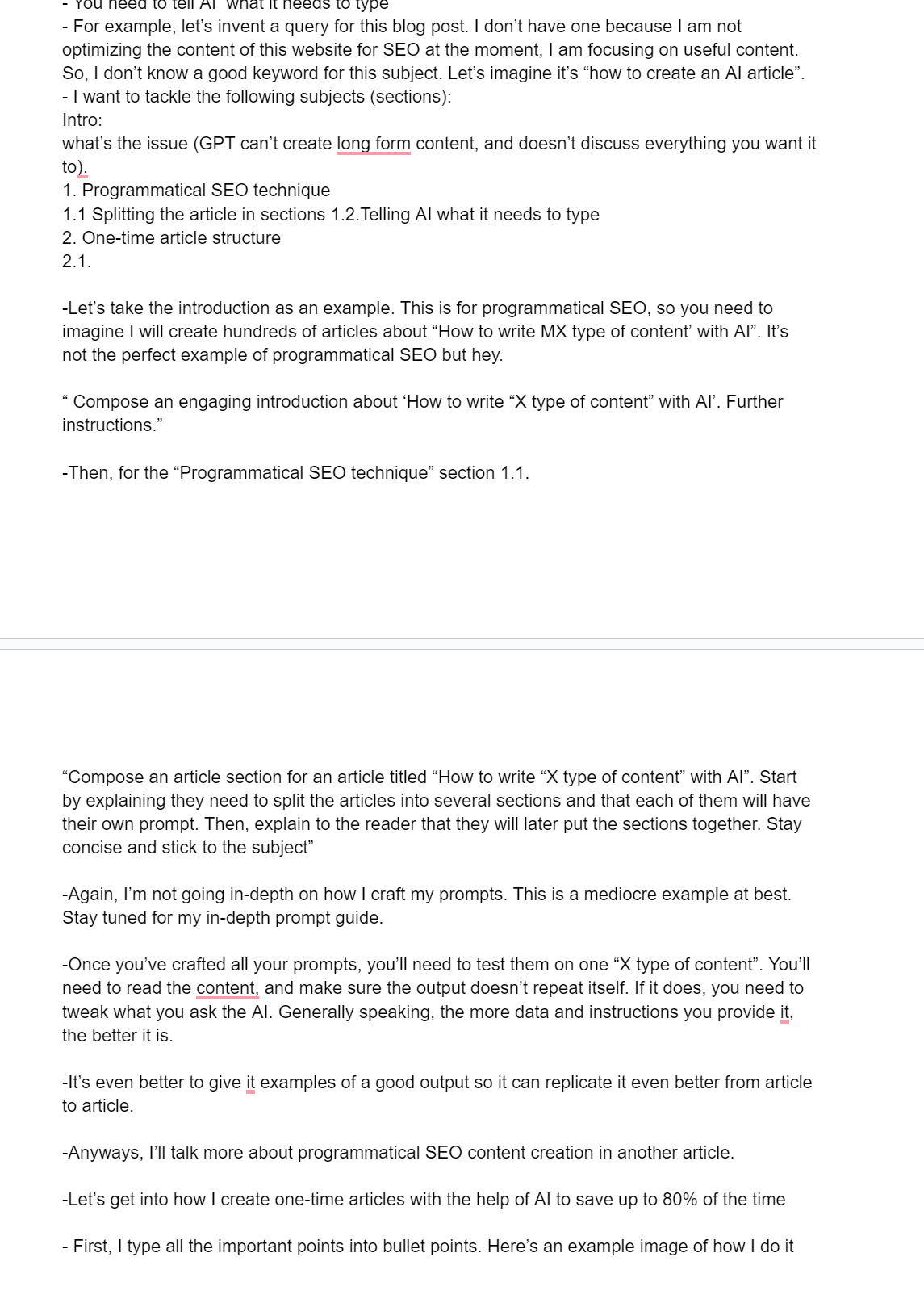Ever asked yourself why your GPT-generated content abruptly ends or doesn’t cover everything you asked it to? Is it feeling empty, unhelpful, or too general? Currently, its frustrating limitation is that it stops creating long-form content, no matter how much tokens you give, between 700 to 1200 words. Not so ideal, right?
You probably think that this AI can perform marvellous tasks like counting; but spoiler alert: it can’t actually count! It will act like it can, but it will lead you astray.
It can be quite a handful trying to comprehend what GPT can and cannot do, but it plays a crucial role in ensuring that your final product isn’t poorly done.
If you’re content with shorter articles with less information (also known as ‘thin content’), this might work perfectly. However, when it comes to more complex topics requiring a detailed approach, the word limit can be a real setback. And I believe, like me, you won’t be settled with such. Exhaustive and comprehensive content is what keeps your readers coming back, isn’t it?
Two types of workflows
Pushing Articles Beyond 700 Words
Here’s a truth bomb: the word limit of 700 to 1200 words often isn’t enough for me! Creating thin, short articles? It’s totally fine. But, when it comes to tackling several points in one article, I feel it falls short of delivering an in-depth understanding.
The Fix: Two New Workflows
To combat this, I’ve implemented two distinct workflows. One is for programmatic SEO – this is for when you’re looking to publish a slew of articles. The alternative workflow is for one-off articles, like the one you’re reading now!
Programmatical SEO (Bulk Content) With AI
Let’s kickstart it with the programmatic SEO approach. Split the article into sections.
Typically, one article section equals one question – this could either be a Google search keyword or a crucial point for understanding the subject matter. Each of these sections would then receive its very own prompt. The article is assembled later on.
Crafting The Perfect Prompt
Now, let’s touch briefly on crafting prompts (stay tuned for a more detailed guide on this by subscribing to my newsletter). You see, the trick lies in telling the AI what it should type up.
A Practical Example
For instance, in this blog post, I am focusing on creating valuable content, not so much on optimizing for SEO – so, I’ll randomly pick a keyword, let’s say: “how to create an AI article”. I’d split it into the following sections:
- An introduction (the problem: GPT can’t create long, comprehensive articles).
- Programmatic SEO technique (splitting the article into sections and instructing the AI).
- One-time article structure.
Let’s Dive In: Crafting Prompts
The introductory part of such articles could receive a prompt like: “Compose an engaging introduction about ‘How to write “X type of content” with AI’.”
The Programmatic SEO technique section could have: “Compose an article section about splitting the article into sections and instructing the AI for an article titled ‘How to write “X type of content” with AI’”.
Remember, this is a brief look into prompt crafting. For a more comprehensive guide, keep an eye out for my in-depth article.
Prompt Testing for Perfect Results
Perfecting your prompts takes a bit of practice. Let’s say you’ve constructed all of them for your chosen ‘X type of content’. The next vital step? Testing the prompts. Scrutinise the generated content meticulously – you’re looking for any patterns of repetition.
Your AI isn’t creating a catchy pop album – it’s crafting an article. So, if it croons the same tune for too many lines, we have a problem. Repetition needs to be eliminated (hey, usually I don’t like AI jokes, but I’ll leave this one here, I smiled a little). Clear instructions and ample data are your weapons against this. The more your AI knows, the better it performs.
The Power of Good Examples
You see, the AI is much like an eager apprentice, ready to mimic the master’s craft. So, why not feed it examples of what you consider successful outputs? This way, it might just come close to replicating that magic from the first article to the very last!
No Data, No Truth
Just a quick heads up: Stripping your AI of data is akin to strapping a blindfold on it. It might make wild, unverified claims. If you aren’t going to use a verified dataset, at least throw the AI a question about how it was trained on your subject matter and its claimed accuracy rate. You don’t want to build your entire website on AI hallucinations.
The Final Patrolling Round
Guess what? You’re coming in as the final quality control agent. Never release an article without thoroughly combing through it.
Think of it as checking for cracks before the great wall of content goes up. Your standard should be seamless perfection – ten flawless outputs in a row is a commendable aim.
We’ll delve deeper into the sea of programmatic SEO content creation soon in another article.
Fluid One-time article pieces
Creating One-Time Articles
Let’s dive into the process I use to craft one-time articles with AI, which helps me save up to 80% of the time.
Breaking Down the Process
First, I jot down all the critical points in bullet form. Imagine it like a skeleton structure before the fleshing-out part. Here’s an example of how I go about it.

Next, I logically split these bullet points into sections. These sections then get their unique prompt for the AI. A perfect example is designing a separate prompt for the introduction.

Quality over Cost
I usually keep the output in GPT’s playground, even if it’s a little more expensive in terms of input tokens. It definitely pays for itself with higher quality, fluid content. Trust me, this tiny investment goes a long way!
Adopt a Read and Edit Approach
As you get further into the article generation, it’s okay to cut out the introduction and earlier parts. Since the last pieces of your article will likely be unrelated to the content of the first few sections, you won’t get repetition from this.
Just keep in mind to read along as the AI writes. This way, you can eliminate any chance of mistakes.
When Price and Precision Collide
You may be tempted to only concentrate on less expensive content and use one prompt at a time without the output history, but you’ll encounter the same problem as with the programmatic SEO – an error rate in your not-so-accurate prompt that fails to identify the mistakes it makes for that particular segment. I’m uncertain if this would genuinely reduce the cost in the end.
Enforce AI’s Memory with Careful Prompts
One essential tip I have for you is about prompts and bullet points. After using a prompt, take it out along with the old bullet points. This clears your space. When you insert the new section’s bullet points, place the prompt at the end again. Why? This ensures your AI stays on track and doesn’t forget what you’re doing. Believe it or not, AI can have forgetful moments too. Plus, doing this avoids wasting tokens on duplicated prompts in your text. Remember, a focused AI equates to a top-notch article.
Reading Along and Making Adjustments
As the AI works its magic, it’s crucial for you to read along. Sometimes, the AI may not quite grasp the essence of your section. But don’t worry, there’s an easy fix. Simply delete the output and submit the prompt again. Persistence pays off – it eventually gets it right.
Finalizing Your Article
Once you’re satisfied with the output, it’s time to bring it all together. Copy and paste your article onto your blog. Add in those essential headers, and voila! You have a polished piece of content, ready to shine.
Creating a Twitter Thread
But wait, there’s more! You can also ask the AI to create a Twitter thread from your content. A few tweaks here and there, and you’ve got a fresh piece of content for your social media audience.
Efficiency at Its Best
Believe it or not, this entire process took me just 45 minutes. Without the help of AI, I would’ve been typing for at least 3 hours. It’s not just about saving time – it’s about efficiency.
The Value of AI
Yes, the content might not be entirely my own creation. It’s not how I would have typed it. Some things bugger me. But here’s the thing – without AI, I wouldn’t have been able to create content pieces like this. Time is a precious resource, and I prefer focusing on tasks that generate revenue. Thanks to AI, I can now have a casual blog about an interesting subject.
Final Touches with Grammarly
One final tip – consider using the Grammarly extension in your text editor. While AI is impressive, it can occasionally make typos. A quick run through Grammarly ensures your article is grammatically spotless.

GPT API integration with Google Sheets
- Streamline your workflow with my GPT API + Google Sheets script, effortlessly converting your thousands of prompts into text delivered straight to your spreadsheets.
- Simply drag your prompts down 10 by 10 and watch GPT send you the text in seconds.
- Fully compatible with GPT 3.5 and 4, this solution enhances your efficiency by seamlessly integrating AI-generated insights, text, and data into your spreadsheets.
